2023 CADILLAC LYRIC ESP
[x] Cancel search: ESPPage 231 of 424

Cadillac Lyriq Owner Manual (GMNA-Localizing-U.S./Canada-15644413) -
2023 - CRC - 2/23/22
230 Driving and Operating
will adjust the vehicle's speed
and attempt to maintain the
follow distance gap selected.
Press
[on the steering
wheel to adjust the following
gap. Each press cycles the gap
button through three settings:
Far, Medium, or Near.
When pressed, the current
gap setting displays briefly on
the instrument cluster. The
gap setting will be maintained
until it is changed.
Far Gap Setting
Medium Gap Setting
Near Gap Setting
Since each gap setting
corresponds to a following
time (Far, Medium, or Near),
the following distance will vary
based on vehicle speed. The
faster the vehicle speed, the
further back your vehicle will
follow a vehicle detected
ahead. Consider traffic and weather conditions when
selecting the following gap.
The range of selectable gaps
may not be appropriate for all
drivers and driving conditions.
Changing the gap setting
automatically changes the
alert timing sensitivity (Far,
Medium, or Near) for the
Forward Collision Alert (FCA)
feature. See Forward Collision
Alert (FCA) System
0270.
Courtesy Gap
Press and hold
[on the
steering wheel when vehicle is
moving to temporarily increase
the gap with the vehicle ahead
to allow for merging traffic.
Press and hold
[when
stopped to cancel ACC from
resuming automatically (if the
stop is brief) and to remain
stationary. This can be used to
allow traffic to merge between
you and the vehicle ahead.
Press RES+ or the accelerator
pedal to resume ACC.
Page 232 of 424

Cadillac Lyriq Owner Manual (GMNA-Localizing-U.S./Canada-15644413) -
2023 - CRC - 2/23/22
Driving and Operating 231
Following distance gap will
return to the original selection
after hold.
Alerting the Driver
If ACC is engaged, driver
action may be required when
ACC cannot apply sufficient
braking because of
approaching a vehicle too
rapidly.
When this condition occurs,
the collision alert symbol will
flash on the windshield. Either
eight beeps will sound from
the front, or both sides of the
Safety Alert Seat will pulse
five times. Touch the Settings
icon on the infotainment home
page. Select“Vehicle”to
display the list of available
options and select “Collision/
Detection Systems”. See Defensive Driving
0196.
Approaching and Following a
Vehicle
The vehicle ahead indicator is
in the instrument cluster.
It only displays when a vehicle
is detected in your vehicle’s
path moving in the same
direction. If this symbol is not
displaying, ACC will not
respond to or brake for
vehicles ahead.
ACC automatically slows the
vehicle down and adjusts
vehicle speed to follow a
detected vehicle ahead at the
selected following gap. The
vehicle speed increases or
decreases to follow a
detected vehicle in front of
your vehicle when that vehicle
is traveling slower than your vehicle set speed. It may apply
limited braking, if necessary.
When braking is active, the
brake lamps will come on. The
automatic braking may feel or
sound different than if the
brakes were applied manually.
This is normal.
Passing a Vehicle While
Using ACC
If the set speed is high
enough, and the left turn
signal is used to pass a vehicle
ahead in the selected
following gap, ACC may assist
by gradually accelerating the
vehicle prior to the lane
change.
{Warning
When using ACC to pass a
vehicle or perform a lane
change, the following
distance to the vehicle being
passed may be reduced.
ACC may not apply
sufficient acceleration or
(Continued)
Page 235 of 424
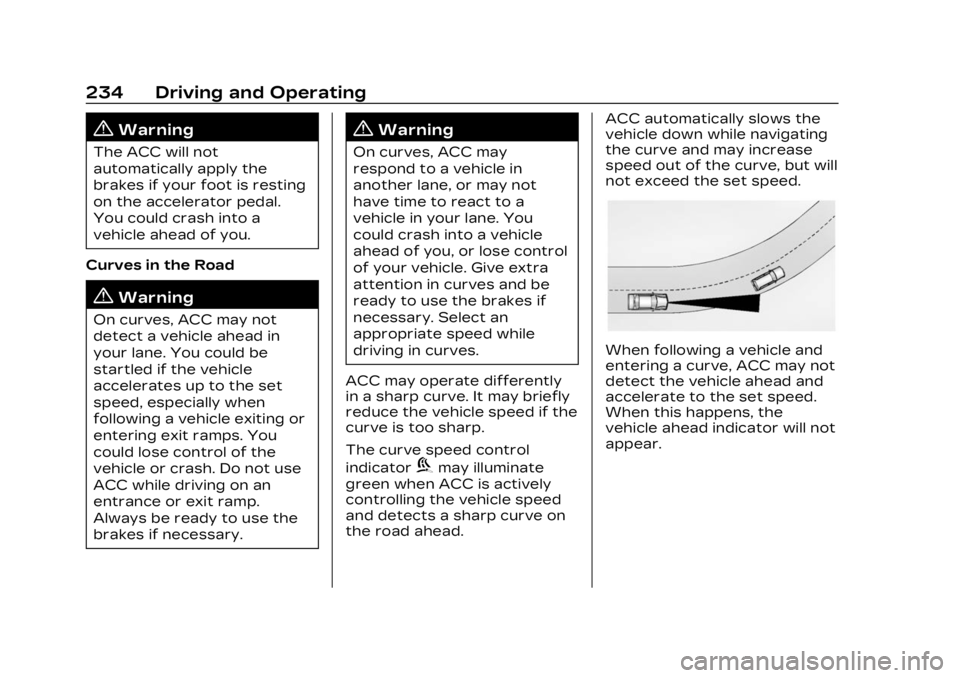
Cadillac Lyriq Owner Manual (GMNA-Localizing-U.S./Canada-15644413) -
2023 - CRC - 2/23/22
234 Driving and Operating
{Warning
The ACC will not
automatically apply the
brakes if your foot is resting
on the accelerator pedal.
You could crash into a
vehicle ahead of you.
Curves in the Road
{Warning
On curves, ACC may not
detect a vehicle ahead in
your lane. You could be
startled if the vehicle
accelerates up to the set
speed, especially when
following a vehicle exiting or
entering exit ramps. You
could lose control of the
vehicle or crash. Do not use
ACC while driving on an
entrance or exit ramp.
Always be ready to use the
brakes if necessary.
{Warning
On curves, ACC may
respond to a vehicle in
another lane, or may not
have time to react to a
vehicle in your lane. You
could crash into a vehicle
ahead of you, or lose control
of your vehicle. Give extra
attention in curves and be
ready to use the brakes if
necessary. Select an
appropriate speed while
driving in curves.
ACC may operate differently
in a sharp curve. It may briefly
reduce the vehicle speed if the
curve is too sharp.
The curve speed control
indicator
bmay illuminate
green when ACC is actively
controlling the vehicle speed
and detects a sharp curve on
the road ahead. ACC automatically slows the
vehicle down while navigating
the curve and may increase
speed out of the curve, but will
not exceed the set speed.
When following a vehicle and
entering a curve, ACC may not
detect the vehicle ahead and
accelerate to the set speed.
When this happens, the
vehicle ahead indicator will not
appear.
Page 236 of 424
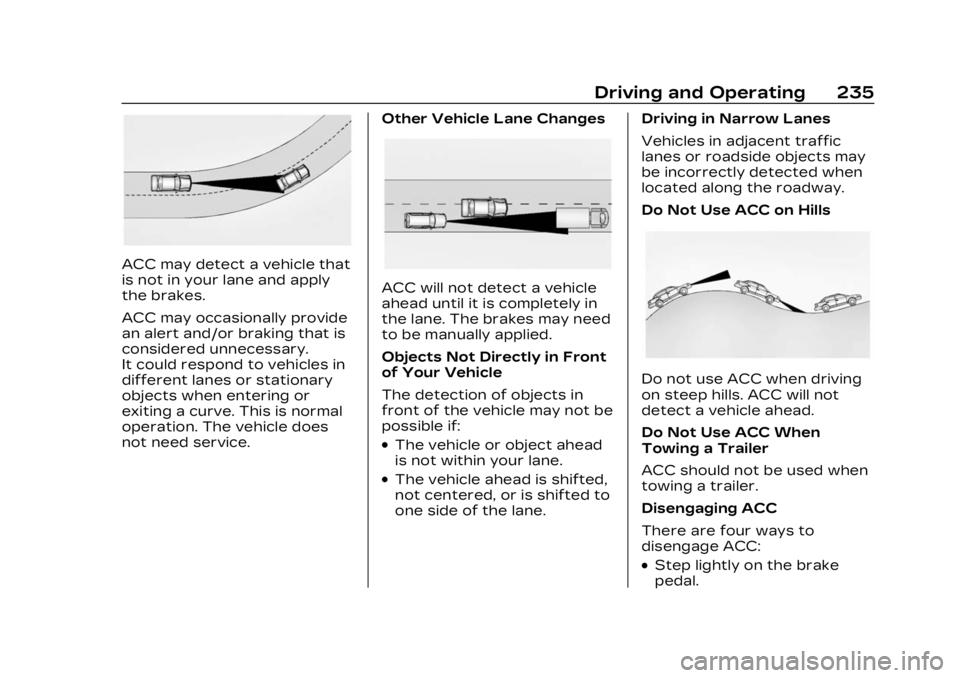
Cadillac Lyriq Owner Manual (GMNA-Localizing-U.S./Canada-15644413) -
2023 - CRC - 2/23/22
Driving and Operating 235
ACC may detect a vehicle that
is not in your lane and apply
the brakes.
ACC may occasionally provide
an alert and/or braking that is
considered unnecessary.
It could respond to vehicles in
different lanes or stationary
objects when entering or
exiting a curve. This is normal
operation. The vehicle does
not need service.Other Vehicle Lane Changes
ACC will not detect a vehicle
ahead until it is completely in
the lane. The brakes may need
to be manually applied.
Objects Not Directly in Front
of Your Vehicle
The detection of objects in
front of the vehicle may not be
possible if:
.The vehicle or object ahead
is not within your lane.
.The vehicle ahead is shifted,
not centered, or is shifted to
one side of the lane.Driving in Narrow Lanes
Vehicles in adjacent traffic
lanes or roadside objects may
be incorrectly detected when
located along the roadway.
Do Not Use ACC on Hills
Do not use ACC when driving
on steep hills. ACC will not
detect a vehicle ahead.
Do Not Use ACC When
Towing a Trailer
ACC should not be used when
towing a trailer.
Disengaging ACC
There are four ways to
disengage ACC:
.Step lightly on the brake
pedal.
Page 238 of 424
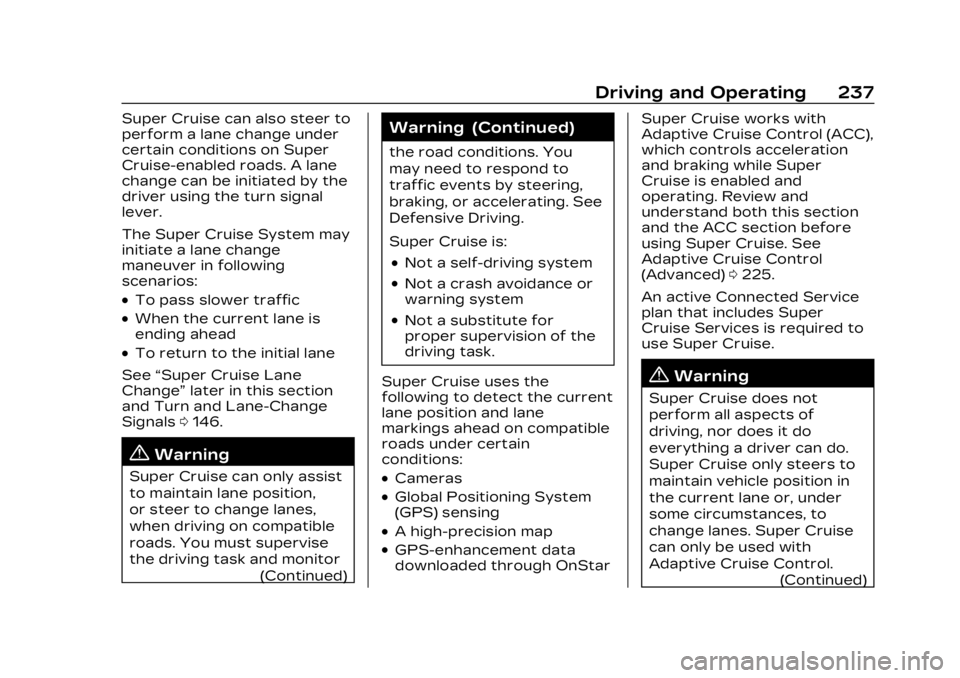
Cadillac Lyriq Owner Manual (GMNA-Localizing-U.S./Canada-15644413) -
2023 - CRC - 2/23/22
Driving and Operating 237
Super Cruise can also steer to
perform a lane change under
certain conditions on Super
Cruise-enabled roads. A lane
change can be initiated by the
driver using the turn signal
lever.
The Super Cruise System may
initiate a lane change
maneuver in following
scenarios:
.To pass slower traffic
.When the current lane is
ending ahead
.To return to the initial lane
See “Super Cruise Lane
Change” later in this section
and Turn and Lane-Change
Signals 0146.
{Warning
Super Cruise can only assist
to maintain lane position,
or steer to change lanes,
when driving on compatible
roads. You must supervise
the driving task and monitor
(Continued)
Warning (Continued)
the road conditions. You
may need to respond to
traffic events by steering,
braking, or accelerating. See
Defensive Driving.
Super Cruise is:
.Not a self-driving system
.Not a crash avoidance or
warning system
.Not a substitute for
proper supervision of the
driving task.
Super Cruise uses the
following to detect the current
lane position and lane
markings ahead on compatible
roads under certain
conditions:
.Cameras
.Global Positioning System
(GPS) sensing
.A high-precision map
.GPS-enhancement data
downloaded through OnStar Super Cruise works with
Adaptive Cruise Control (ACC),
which controls acceleration
and braking while Super
Cruise is enabled and
operating. Review and
understand both this section
and the ACC section before
using Super Cruise. See
Adaptive Cruise Control
(Advanced)
0225.
An active Connected Service
plan that includes Super
Cruise Services is required to
use Super Cruise.
{Warning
Super Cruise does not
perform all aspects of
driving, nor does it do
everything a driver can do.
Super Cruise only steers to
maintain vehicle position in
the current lane or, under
some circumstances, to
change lanes. Super Cruise
can only be used with
Adaptive Cruise Control. (Continued)
Page 239 of 424
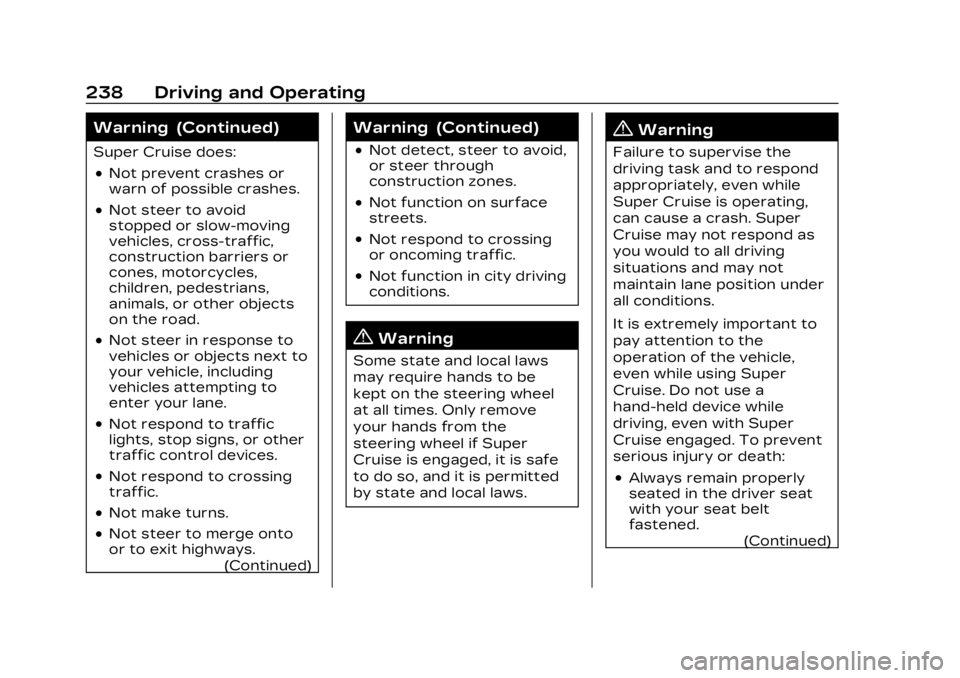
Cadillac Lyriq Owner Manual (GMNA-Localizing-U.S./Canada-15644413) -
2023 - CRC - 2/23/22
238 Driving and Operating
Warning (Continued)
Super Cruise does:
.Not prevent crashes or
warn of possible crashes.
.Not steer to avoid
stopped or slow-moving
vehicles, cross-traffic,
construction barriers or
cones, motorcycles,
children, pedestrians,
animals, or other objects
on the road.
.Not steer in response to
vehicles or objects next to
your vehicle, including
vehicles attempting to
enter your lane.
.Not respond to traffic
lights, stop signs, or other
traffic control devices.
.Not respond to crossing
traffic.
.Not make turns.
.Not steer to merge onto
or to exit highways.(Continued)
Warning (Continued)
.Not detect, steer to avoid,
or steer through
construction zones.
.Not function on surface
streets.
.Not respond to crossing
or oncoming traffic.
.Not function in city driving
conditions.
{Warning
Some state and local laws
may require hands to be
kept on the steering wheel
at all times. Only remove
your hands from the
steering wheel if Super
Cruise is engaged, it is safe
to do so, and it is permitted
by state and local laws.
{Warning
Failure to supervise the
driving task and to respond
appropriately, even while
Super Cruise is operating,
can cause a crash. Super
Cruise may not respond as
you would to all driving
situations and may not
maintain lane position under
all conditions.
It is extremely important to
pay attention to the
operation of the vehicle,
even while using Super
Cruise. Do not use a
hand-held device while
driving, even with Super
Cruise engaged. To prevent
serious injury or death:
.Always remain properly
seated in the driver seat
with your seat belt
fastened.(Continued)
Page 245 of 424

Cadillac Lyriq Owner Manual (GMNA-Localizing-U.S./Canada-15644413) -
2023 - CRC - 2/23/22
244 Driving and Operating
.Super Cruise is unable to
complete the lane change
maneuver.
Attention to the Road
{Warning
Super Cruise is a driver
assistance system and
cannot accurately detect or
predict all situations. Super
Cruise is not a crash
avoidance system. To
prevent serious injury or
death, you must supervise
the driving task and monitor
the road conditions. You
may need to respond to
traffic events by steering,
braking, or accelerating. See
Defensive Driving 0196.
Super Cruise also cannot
determine whether you are
awake, asleep, impaired,
or properly focused on safe
driving. The vehicle could
crash into other vehicles,
drive out of the lane, or drive (Continued)
Warning (Continued)
off the road. Complete
attention is always required
while driving, even while
using Super Cruise. Be
prepared to take over
steering or apply the brakes
at any time.
{Warning
To prevent serious injury or
death, be alert and pay
special attention when
passing highway exits,
entrances, and crossings
with Super Cruise, and be
ready to take control of the
vehicle when necessary.
Changes in lane markings
around exits and entrances
can momentarily cause
Super Cruise to not detect
the correct lane. If this
occurs, Super Cruise may
attempt steering inputs to
(Continued)
Warning (Continued)
bring the vehicle back into
the correct lane and, in rare
circumstances, could
over-correct and cause the
vehicle to momentarily cross
into a lane next to your
vehicle unless you manually
steer to maintain your lane
position.
The Driver Attention System
(DAS) on the steering column
continually monitors driver
head and eye position to
estimate driver attention to
the road. The camera does not
record or share pictures,
audio, or video.
Sunglasses, hats, or other
types of clothing that change
the shape of the head may
interfere with camera
performance. To improve
camera performance, raise or
lower the steering wheel,
or change the seat position.
Page 247 of 424
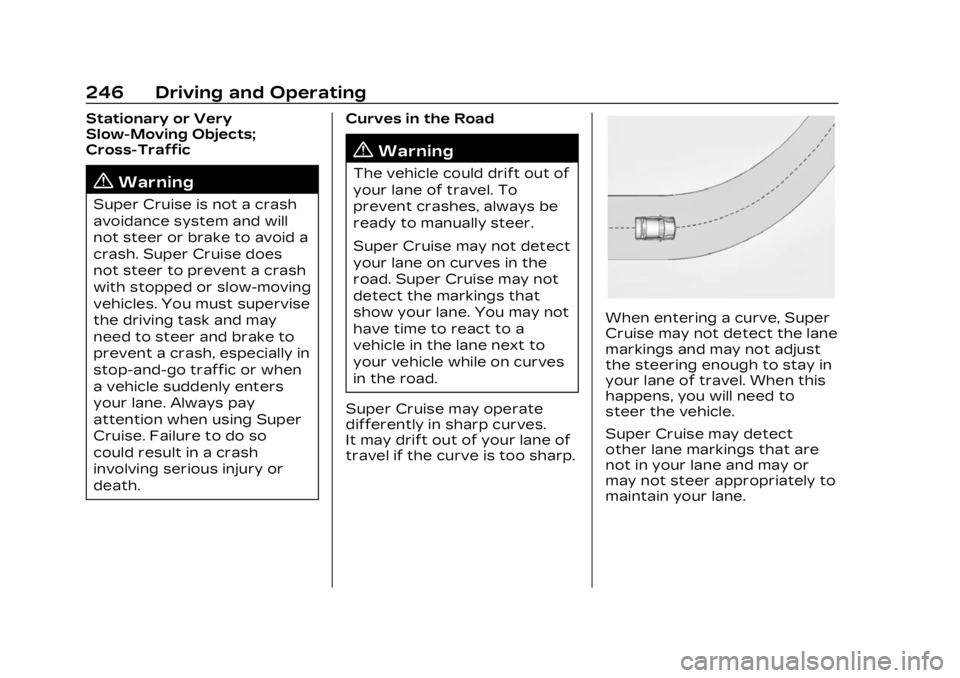
Cadillac Lyriq Owner Manual (GMNA-Localizing-U.S./Canada-15644413) -
2023 - CRC - 2/23/22
246 Driving and Operating
Stationary or Very
Slow-Moving Objects;
Cross-Traffic
{Warning
Super Cruise is not a crash
avoidance system and will
not steer or brake to avoid a
crash. Super Cruise does
not steer to prevent a crash
with stopped or slow-moving
vehicles. You must supervise
the driving task and may
need to steer and brake to
prevent a crash, especially in
stop-and-go traffic or when
a vehicle suddenly enters
your lane. Always pay
attention when using Super
Cruise. Failure to do so
could result in a crash
involving serious injury or
death.Curves in the Road
{Warning
The vehicle could drift out of
your lane of travel. To
prevent crashes, always be
ready to manually steer.
Super Cruise may not detect
your lane on curves in the
road. Super Cruise may not
detect the markings that
show your lane. You may not
have time to react to a
vehicle in the lane next to
your vehicle while on curves
in the road.
Super Cruise may operate
differently in sharp curves.
It may drift out of your lane of
travel if the curve is too sharp.
When entering a curve, Super
Cruise may not detect the lane
markings and may not adjust
the steering enough to stay in
your lane of travel. When this
happens, you will need to
steer the vehicle.
Super Cruise may detect
other lane markings that are
not in your lane and may or
may not steer appropriately to
maintain your lane.